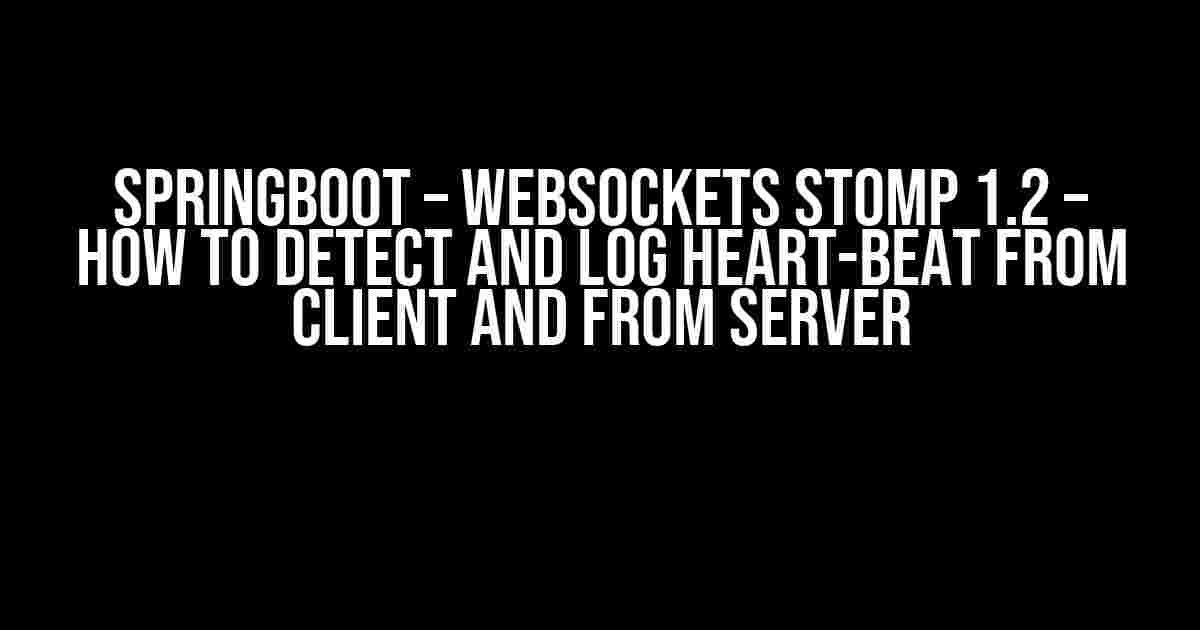Ah, the wonders of WebSockets and STOMP! In this article, we’re going to dive deep into the world of real-time communication and explore the fascinating realm of heartbeats. You’ll learn how to detect and log heartbeats from both the client and server sides using SpringBoot and STOMP 1.2. Buckle up, folks, and let’s get started!
What are Heartbeats?
Before we dive into the How-To section, let’s take a quick detour to understand what heartbeats are. In the context of WebSockets and STOMP, heartbeats are a mechanism to ensure that the connection between the client and server remains active and healthy. It’s a way for the client and server to say, “Hey, I’m still here!” and to detect any potential issues with the connection.
Think of heartbeats like the pulse of a living being. Just as a pulse indicates that a person is alive, heartbeats in WebSockets and STOMP indicate that the connection is alive and kicking!
Why are Heartbeats Important?
So, why are heartbeats crucial in WebSockets and STOMP? Well, here are a few reasons:
- Connection Health Monitoring**: Heartbeats allow the client and server to monitor the health of the connection and detect any issues or disconnections.
- Idle Connection Detection**: Heartbeats help identify idle connections, which can be closed to conserve resources and improve system performance.
- Fault Tolerance**: Heartbeats enable the client and server to detect and recover from faults, such as network failures or server restarts.
Detecting and Logging Heartbeats from the Client Side
Now that we’ve covered the basics, let’s get our hands dirty and start implementing heartbeat detection and logging from the client side. We’ll use JavaScript and the popular SockJS library to connect to our SpringBoot server.
Client-Side Code
<script src="https://cdn.jsdelivr.net/npm/[email protected]/dist/sockjs.min.js"></script> <script> let socket = new SockJS('/websocket'); let stompClient = Stomp.over(socket); stompClient.connect({}, function (frame) { console.log('Connected to the server'); // Subscribe to the heartbeat topic stompClient.subscribe('/topic/heartbeat', function (message) { console.log('Received heartbeat from the server:', message); }); }); </script>
In the above code, we create a new SockJS instance and connect to our SpringBoot server using the Stomp.over method. Once connected, we subscribe to the /topic/heartbeat topic to receive heartbeat messages from the server.
Detecting and Logging Heartbeats from the Server Side
Now, let’s shift our focus to the server side and explore how to detect and log heartbeats using SpringBoot and STOMP 1.2.
Server-Side Code
@EnableWebSocket
public class WebSocketConfig implements WebSocketConfigurer {
@Override
public void registerWebSocketHandlers(WebSocketHandlerRegistry registry) {
registry.addHandler(myWebSocketHandler(), "/websocket").setHandshakeHandler(new DefaultHandshakeHandler());
}
@Bean
public MyWebSocketHandler myWebSocketHandler() {
return new MyWebSocketHandler();
}
}
public class MyWebSocketHandler extends TextWebSocketHandler {
@Autowired
private SimpMessagingTemplate messagingTemplate;
@Override
public void handleTextMessage(WebSocketSession session, TextMessage message) throws Exception {
// Handle incoming messages from the client
}
@Override
public void afterConnectionEstablished(WebSocketSession session) throws Exception {
// Send heartbeats to the client at regular intervals
messagingTemplate.convertAndSend("/topic/heartbeat", "Heartbeat from the server!");
// Log heartbeats
logHeartbeat(session);
}
private void logHeartbeat(WebSocketSession session) {
System.out.println("Received heartbeat from the client: " + session.isOpen());
}
}
In the above code, we create a SpringBoot WebSocket configuration class and define a custom WebSocket handler. In the afterConnectionEstablished method, we send heartbeats to the client at regular intervals using the SimpMessagingTemplate. We also log heartbeats from the client using the logHeartbeat method.
Configuring STOMP 1.2
To enable STOMP 1.2 in our SpringBoot application, we need to add the following configuration:
@Configuration
public class StompConfig extends StompConfigurerSupport {
@Override
public void configureMessageBroker(MessageBrokerRegistry registry) {
registry.setApplicationDestinationPrefixes("/app");
registry.enableSimpleBroker("/topic");
}
@Override
public void registerStompEndpoints(StompEndpointRegistry registry) {
registry.addEndpoint("/websocket").withSockJS();
}
}
In the above configuration, we enable STOMP 1.2 and define a simple broker that handles messages to and from the client.
Conclusion
And there you have it, folks! In this article, we’ve explored the wonderful world of WebSockets, STOMP 1.2, and heartbeats. We’ve learned how to detect and log heartbeats from both the client and server sides using SpringBoot and STOMP 1.2.
Remember, heartbeats are an essential aspect of WebSocket communication, and their detection and logging can help you build more robust and fault-tolerant systems.
So, next time you’re building a real-time application with WebSockets and STOMP, don’t forget to include heartbeats in your toolkit!
| Keyword | Description |
|---|---|
| A popular Java-based framework for building web applications | |
| Websockets | A bi-directional, real-time communication protocol between client and server |
| STOMP 1.2 | A simple, text-based messaging protocol for WebSocket communication |
| Heartbeats | A mechanism to ensure connection health and detect potential issues |
Frequently Asked Question
Get the inside scoop on detecting and logging heart-beats from clients and servers using SpringBoot, Websockets, and STOMP 1.2!
How can I detect heart-beats from clients using STOMP 1.2 in SpringBoot?
You can detect heart-beats from clients by overriding the handleTick method in the StompSessionHandlerAdapter class. This method is called whenever a heart-beat message is received from the client. Simply log the heart-beat event or perform any necessary actions within this method.
How do I enable heart-beats from the server side using STOMP 1.2 in SpringBoot?
To enable heart-beats from the server side, you need to configure the Stomp Broker Relay in your SpringBoot application. Set the heartbeat property to a non-zero value (e.g., 10000 for 10 seconds) in the StompBrokerRelayMessageHandler. This will send heart-beat messages to connected clients at the specified interval.
Can I customize the heart-beat interval for specific clients or channels using STOMP 1.2 in SpringBoot?
Yes, you can customize the heart-beat interval for specific clients or channels by implementing a custom StompSessionHandler and overriding the configureFrame method. This method allows you to set custom heart-beat intervals for individual clients or channels based on your application’s requirements.
How can I log heart-beat messages from clients using STOMP 1.2 in SpringBoot?
You can log heart-beat messages from clients by implementing a custom StompSessionHandlerAdapter and overriding the handleTick method. Within this method, log the heart-beat event using your preferred logging framework, such as Logback or Log4j.
Are there any performance considerations when using heart-beats with STOMP 1.2 in SpringBoot?
Yes, heart-beats can impact performance, especially with a large number of connected clients. To mitigate this, consider increasing the heart-beat interval, implementing connection timeout handling, and optimizing your server’s resources (e.g., increasing the number of threads or instances). Monitor your application’s performance and adjust the heart-beat configuration accordingly.



